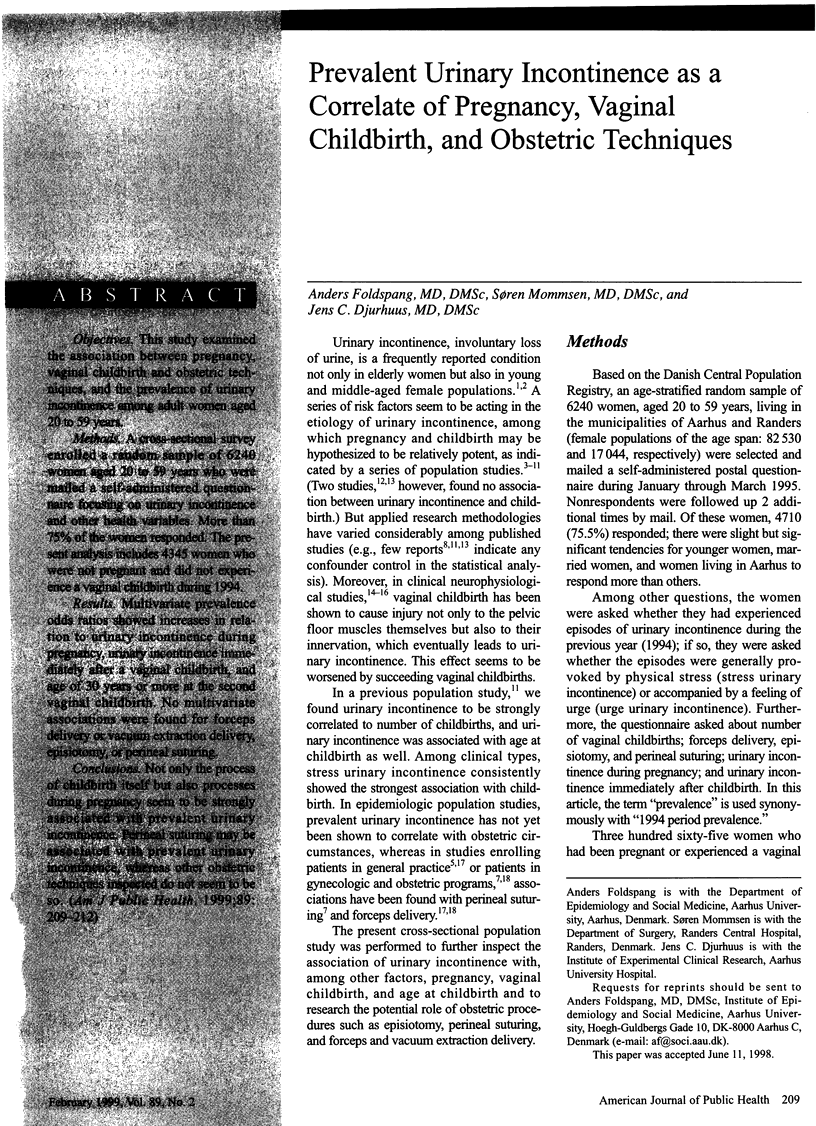Abstract
OBJECTIVES: This study examined the association between pregnancy, vaginal childbirth and obstetric techniques, and the prevalence of urinary incontinence among adult women aged 20 to 59 years. METHODS: A cross-sectional survey enrolled a random sample of 6240 women aged 20 to 59 years who were mailed a self-administered questionnaire focusing on urinary incontinence and other health variables. More than 75% of the women responded. The present analysis includes 4345 women who were not pregnant and did not experience a vaginal childbirth during 1994. RESULTS: Multivariate prevalence odds ratios showed increases in relation to urinary incontinence during pregnancy, urinary incontinence immediately after a vaginal childbirth, and age of 30 years or more at the second vaginal childbirth. No multivariate associations were found for forceps delivery or vacuum extraction delivery, episiotomy, or perineal suturing. CONCLUSION: Not only the process of childbirth itself but also processes during pregnancy seem to be strongly associated with prevalent urinary incontinence. Perineal suturing may be associated with prevalent urinary incontinence, whereas other obstetric techniques inspected do not seem to be so.
Full text
PDF



Selected References
These references are in PubMed. This may not be the complete list of references from this article.
- Chiarelli P., Campbell E. Incontinence during pregnancy. Prevalence and opportunities for continence promotion. Aust N Z J Obstet Gynaecol. 1997 Feb;37(1):66–73. doi: 10.1111/j.1479-828x.1997.tb02220.x. [DOI] [PubMed] [Google Scholar]
- Crist T., Singleton H. M., Koch G. G. Stress incontinence and the nulliparous patient. Obstet Gynecol. 1972 Jul;40(1):13–17. [PubMed] [Google Scholar]
- Diokno A. C., Brock B. M., Herzog A. R., Bromberg J. Medical correlates of urinary incontinence in the elderly. Urology. 1990 Aug;36(2):129–138. doi: 10.1016/0090-4295(90)80211-5. [DOI] [PubMed] [Google Scholar]
- Elving L. B., Foldspang A., Lam G. W., Mommsen S. Descriptive epidemiology of urinary incontinence in 3,100 women age 30-59. Scand J Urol Nephrol Suppl. 1989;125:37–43. [PubMed] [Google Scholar]
- Foldspang A., Mommsen S., Lam G. W., Elving L. Parity as a correlate of adult female urinary incontinence prevalence. J Epidemiol Community Health. 1992 Dec;46(6):595–600. doi: 10.1136/jech.46.6.595. [DOI] [PMC free article] [PubMed] [Google Scholar]
- Hagstad A., Janson P. O. The epidemiology of climacteric symptoms. Acta Obstet Gynecol Scand Suppl. 1986;134:59–65. doi: 10.3109/00016348609157052. [DOI] [PubMed] [Google Scholar]
- Herzog A. R., Fultz N. H. Prevalence and incidence of urinary incontinence in community-dwelling populations. J Am Geriatr Soc. 1990 Mar;38(3):273–281. doi: 10.1111/j.1532-5415.1990.tb03504.x. [DOI] [PubMed] [Google Scholar]
- Hørding U., Pedersen K. H., Sidenius K., Hedegaard L. Urinary incontinence in 45-year-old women. An epidemiological survey. Scand J Urol Nephrol. 1986;20(3):183–186. doi: 10.3109/00365598609024491. [DOI] [PubMed] [Google Scholar]
- Iosif S., Henriksson L., Ulmsten U. The frequency of disorders of the lower urinary tract, urinary incontinence in particular, as evaluated by a questionnaire survey in a gynecological health control population. Acta Obstet Gynecol Scand. 1981;60(1):71–76. doi: 10.3109/00016348109154113. [DOI] [PubMed] [Google Scholar]
- Jolleys J. V. Reported prevalence of urinary incontinence in women in a general practice. Br Med J (Clin Res Ed) 1988 May 7;296(6632):1300–1302. doi: 10.1136/bmj.296.6632.1300. [DOI] [PMC free article] [PubMed] [Google Scholar]
- Minaire P., Jacquetin B. La prévalence de l'incontinence urinaire féminine en médecine générale. J Gynecol Obstet Biol Reprod (Paris) 1992;21(7):731–738. [PubMed] [Google Scholar]
- Snooks S. J., Setchell M., Swash M., Henry M. M. Injury to innervation of pelvic floor sphincter musculature in childbirth. Lancet. 1984 Sep 8;2(8402):546–550. doi: 10.1016/s0140-6736(84)90766-9. [DOI] [PubMed] [Google Scholar]
- Snooks S. J., Swash M., Mathers S. E., Henry M. M. Effect of vaginal delivery on the pelvic floor: a 5-year follow-up. Br J Surg. 1990 Dec;77(12):1358–1360. doi: 10.1002/bjs.1800771213. [DOI] [PubMed] [Google Scholar]
- Sommer P., Bauer T., Nielsen K. K., Kristensen E. S., Hermann G. G., Steven K., Nordling J. Voiding patterns and prevalence of incontinence in women. A questionnaire survey. Br J Urol. 1990 Jul;66(1):12–15. doi: 10.1111/j.1464-410x.1990.tb14855.x. [DOI] [PubMed] [Google Scholar]
- Swash M., Snooks S. J., Henry M. M. Unifying concept of pelvic floor disorders and incontinence. J R Soc Med. 1985 Nov;78(11):906–911. doi: 10.1177/014107688507801105. [DOI] [PMC free article] [PubMed] [Google Scholar]
- Teasdale T. A., Taffet G. E., Luchi R. J., Adam E. Urinary incontinence in a community-residing elderly population. J Am Geriatr Soc. 1988 Jul;36(7):600–606. doi: 10.1111/j.1532-5415.1988.tb06153.x. [DOI] [PubMed] [Google Scholar]
- Thomas T. M., Plymat K. R., Blannin J., Meade T. W. Prevalence of urinary incontinence. Br Med J. 1980 Nov 8;281(6250):1243–1245. doi: 10.1136/bmj.281.6250.1243. [DOI] [PMC free article] [PubMed] [Google Scholar]


